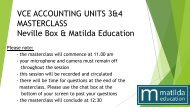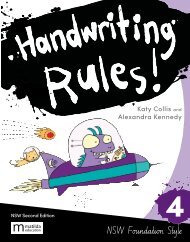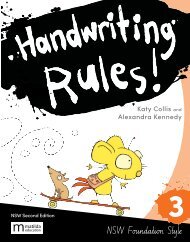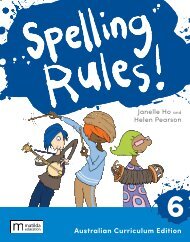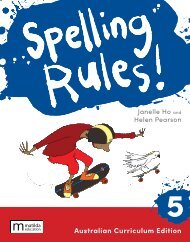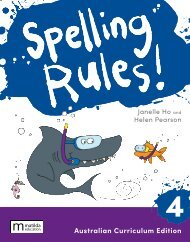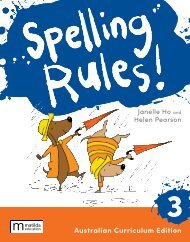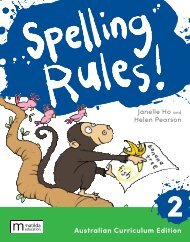All you need to teach drama (ages 5-8) sample/look inside
Create successful ePaper yourself
Turn your PDF publications into a flip-book with our unique Google optimized e-Paper software.
AGES<br />
5-8<br />
DRAMA<br />
DRAMA<br />
Learning through<br />
movement,<br />
improvisation,<br />
mime<br />
and<br />
speech<br />
Julie Chiert<br />
Becky Hunsberger
and speech<br />
DRAMA<br />
Ages 5–8<br />
Learning through<br />
movement,<br />
improvisation,<br />
mime<br />
Julie Chiert<br />
Becky Hunsberger
Dedication:<br />
Thank <strong>you</strong> for <strong>you</strong>r love and support, Mark and Steve.<br />
For all our children, thank <strong>you</strong> for the inspiration.<br />
This edition published in 2021 by<br />
Matilda Education Australia, an imprint<br />
of Meanwhile Education Pty Ltd<br />
Level 1/274 Brunswick St<br />
Fitzroy, Vic<strong>to</strong>ria Australia 3065<br />
T: 1300 277 235<br />
E: cus<strong>to</strong>mersupport@matildaed.com.au<br />
www.matildaeducation.com.au<br />
First edition published 2004 by Macmillan Science and Education Australia Pty Ltd<br />
Copyright © Julie Chiert/Becky Hunsberger/Macmillan Education Australia 2004<br />
<strong>All</strong> You Need <strong>to</strong> Teach Drama Ages 5–8<br />
ISBN 978 0 7329 9264 4<br />
Edited by Helena New<strong>to</strong>n<br />
Design by Trish Hayes<br />
Illustrations by Stephen Michael King<br />
Printed in by <br />
1 2 3 4 5 6 7 25 24 23 22 21 20<br />
Copying of this work by educational institutions or <strong>teach</strong>ers<br />
The purchasing educational institution and its staff, or the purchasing<br />
individual <strong>teach</strong>er, may only reproduce p<strong>ages</strong> within this book in<br />
accordance with the Copyright Act 1968 of Australia (the Act) and<br />
provided the educational institution (or body that administers it) has<br />
given a remuneration notice <strong>to</strong> the Copyright Agency Limited (CAL)<br />
under the Act.<br />
For details of the CAL licence for educational institutions, contact:<br />
Copyright Agency Limited<br />
Level 11, 66 Goulburn Street<br />
Sydney NSW 2000<br />
Telephone (02) 9394 7600<br />
Facsimile (02) 9394 7601<br />
Email info@copyright.com.au<br />
Reproduction and communication for other purposes<br />
Except as permitted under the Act (for example, any fair dealing for<br />
the purposes of study, research, criticism or review), no part of this<br />
book may be reproduced, s<strong>to</strong>red in a retrieval system, communicated<br />
or transmitted in any form or by any means without prior written<br />
permission. <strong>All</strong> inquiries should be made <strong>to</strong> the publisher.
Contents<br />
How <strong>to</strong> Use This Book................................................................................... 4<br />
Curriculum Links Chart................................................................................. 6<br />
<strong>All</strong> the Teaching Tips You Need........................................................... 8<br />
Getting Ready for Drama............................................................................ 9<br />
In Role................................................................................................................... 10<br />
Imagination......................................................................................................... 11<br />
Theatrical Terms Glossary........................................................................ 12<br />
Assessing Drama............................................................................................... 14<br />
Assessment Record Sheet............................................................................ 15<br />
Student Self-Assessment Sheet................................................................. 16<br />
Dynamic Drama Performance Award Sheet.................................... 17<br />
Awesome Audience Member Award Sheet......................................... 18<br />
<strong>All</strong> the Lesson Plans You Need.......................................................... 19<br />
1. The Teddy Bears’ Picnic........................................................................... 20<br />
2. Toy Box........................................................................................................ 22<br />
3. Kangaroo Capers....................................................................................... 24<br />
4. Mischief Makers......................................................................................... 26<br />
5. Zoo-mania................................................................................................... 28<br />
6. The OK Corral............................................................................................ 30<br />
7. Doggie Olympics....................................................................................... 32<br />
8. Buzzing Bees............................................................................................... 34<br />
9. School Days................................................................................................. 36<br />
10. Transport...................................................................................................... 38<br />
11. The Ride of Your Life............................................................................... 40<br />
12. Bug-eyed...................................................................................................... 42<br />
13. Send in the Clowns................................................................................... 44<br />
14. Communication Skills............................................................................... 46<br />
15. Where Are You?........................................................................................ 48<br />
16. Party, Party, Party!.................................................................................... 50<br />
17. Imagine!....................................................................................................... 52<br />
18. Somewhere over the Rainbow............................................................... 54<br />
19. Pirates Ahoy!............................................................................................... 56<br />
20. Bookworms.................................................................................................. 58<br />
21. An Eye for Detail....................................................................................... 60<br />
22. Garden Gnomes......................................................................................... 62<br />
23. Actions Go!................................................................................................. 64<br />
24. Being Scene................................................................................................. 66<br />
25. Cookie Thief................................................................................................ 68<br />
<strong>All</strong> the Task Cards You Need............................................................. 70
How <strong>to</strong> Use This Book<br />
<strong>All</strong> You Need <strong>to</strong> Teach Drama Ages 5-8 is the first in a series of three texts designed <strong>to</strong> give<br />
<strong>teach</strong>ers the <strong>to</strong>ols <strong>to</strong> develop students’ <strong>drama</strong>tic abilities. Drama can be a hugely enriching and<br />
cultivating experience. Students learn through movement, improvisation, mime and speech. They<br />
learn <strong>to</strong> appreciate the <strong>drama</strong>tic abilities of their peers and also gain confidence in themselves.<br />
By participating in varied independent, paired and group activities, students will develop selfesteem,<br />
trust and cooperation skills.<br />
The <strong>All</strong> You Need <strong>to</strong> Teach Drama series is a <strong>teach</strong>er-friendly resource. Activities have been<br />
written in an easy-<strong>to</strong>-follow format that all <strong>teach</strong>ers – regardless of their <strong>drama</strong>tic expertise –<br />
can use. This book caters for <strong>teach</strong>ers of students in the first three years of primary school and<br />
is divided in<strong>to</strong> three parts.<br />
<strong>All</strong> the Teaching Tips You Need presents useful advice on preparing for <strong>drama</strong>, encouraging<br />
students <strong>to</strong> perform for others, developing imagination and reflecting on learning. This<br />
section also contains a handy theatrical terms glossary and suggestions for assessing students’<br />
development in <strong>drama</strong>. Reproducible assessment sheets for both <strong>teach</strong>ers and students are<br />
included <strong>to</strong> facilitate the assessment process. ‘Dynamic Drama Performance’ and ‘Awesome<br />
Audience Member’ awards are provided <strong>to</strong> encourage students <strong>to</strong> build on their <strong>drama</strong> and<br />
listening skills.<br />
<strong>All</strong> the Lesson Plans You Need contains 25 lesson plans providing interesting and engaging<br />
ways for students <strong>to</strong> learn through <strong>drama</strong>. Each lesson is divided in<strong>to</strong> a warm-up, speech and<br />
enunciation practice, a movement activity and a <strong>drama</strong> activity.<br />
<strong>All</strong> the Task Cards You Need contains ten p<strong>ages</strong> of scenario/character cards designed <strong>to</strong> be<br />
pho<strong>to</strong>copied, cut out, laminated and reused. These are linked <strong>to</strong> the <strong>drama</strong> or warm-up activities<br />
and students can use them as starting points for developing creative pieces.<br />
Working in Groups<br />
Some activities involve students working in pairs or groups. You can decide how the class will<br />
be divided. You may decide <strong>to</strong> give the students the opportunity <strong>to</strong> choose their own groups or<br />
pairs. This can develop independence and responsibility. You may <strong>need</strong> <strong>to</strong> select collaborative<br />
groups of varied levels of expertise <strong>to</strong> allow students <strong>to</strong> positively influence each other. The more<br />
enthusiastic students may encourage shy students <strong>to</strong> express themselves.<br />
Sometimes students will act as the audience for another group. This encour<strong>ages</strong> students<br />
<strong>to</strong> appreciate the performances of their peers. When activities involve both performers and<br />
audience members, <strong>teach</strong>ers should praise and encourage appropriate behaviour, including<br />
active listening and offering positive feedback <strong>to</strong> the performers when required, for example ‘I<br />
liked the way <strong>you</strong> hopped like a kangaroo when <strong>you</strong> were acting as a kangaroo.’<br />
4
Lesson Structure<br />
Drama lessons can be incorporated in<strong>to</strong> the class timetable for approximately 45 minutes each<br />
week. A recommended approach <strong>to</strong> this book is <strong>to</strong> go through each lesson in order. The earlier<br />
lessons introduce basic <strong>drama</strong>tic skills, experiences and knowledge. The lessons gradually become<br />
more challenging, developing and building on skills previously learnt.<br />
The activities in each lesson maximise students’ motivation and heighten interest while developing<br />
<strong>drama</strong> skills. Should students show extreme interest or enthusiasm for a particular activity, <strong>you</strong><br />
may decide <strong>to</strong> repeat or extend it. You may wish <strong>to</strong> complete specific activities over a number of<br />
lessons if <strong>you</strong> feel that this will invite more creative work from the students.<br />
Each lesson in this book is broken up in<strong>to</strong> four parts: warm-up, speech and enunciation,<br />
movement and a <strong>drama</strong> activity.<br />
Warm-up<br />
Warm-ups allow students <strong>to</strong> actively engage in introduc<strong>to</strong>ry <strong>drama</strong> activities, as well as<br />
establishing an energy level for the rest of the lesson. It is important that students are relaxed<br />
and focussed at the beginning of a lesson. Therefore, warm-up activities consist mainly of games<br />
that <strong>teach</strong> children control, initiative, support for peers and confidence.<br />
Speech and Enunciation<br />
Ac<strong>to</strong>rs warm up and train their voices so that they can clearly convey mess<strong>ages</strong> <strong>to</strong> an audience<br />
without damaging their vocal cords. Activities in this book <strong>teach</strong> techniques <strong>to</strong> exercise jaw<br />
muscles, alter pitch, emphasise for effect and articulate clearly. Students will develop their<br />
enunciation skills, integrating this clarity in<strong>to</strong> other <strong>drama</strong> activities, as well as improving their<br />
everyday speech and communication skills. Many of the lessons in this book encourage students<br />
<strong>to</strong> focus on their improvised speech skills.<br />
Movement<br />
Movement is a form of <strong>drama</strong>tic expression. This book focusses on three different<br />
types of movement: body awareness, spatial awareness and dance <strong>drama</strong>.<br />
Body awareness allows students <strong>to</strong> manipulate their<br />
bodies <strong>to</strong> create an image or effect.<br />
Spatial awareness makes students aware of their<br />
physical environment, be it real or imaginary.<br />
Dance <strong>drama</strong> allows students <strong>to</strong> use both body and<br />
spatial awareness skills <strong>to</strong> create short role-plays.<br />
These are based on a piece of music and directed<br />
by the <strong>teach</strong>er.<br />
These three forms of movement allow students <strong>to</strong> deliver a performance with minimal speech.<br />
Students can then focus on body movements and facial expressions <strong>to</strong> get their message across.<br />
Movement is as important as speech for creative expression. If emphasis is placed on movement<br />
exercises, students will move more naturally during <strong>drama</strong>tic performances when the focus is on<br />
the whole piece.<br />
Drama Activity<br />
Each lesson builds up <strong>to</strong> the major <strong>drama</strong> activity. The <strong>drama</strong> activities vary, introducing role-play,<br />
improvisation and performance. Students will evolve as ac<strong>to</strong>rs through non-threatening experiences.<br />
For <strong>you</strong>r convenience, reproducible task cards linked <strong>to</strong> <strong>drama</strong> or warm-up activities have been<br />
included for some lessons. These can be found on p<strong>ages</strong> 70 <strong>to</strong> 80.<br />
At the end of each lesson are suggestions on how <strong>to</strong> link the <strong>drama</strong> lessons with other creative<br />
arts lessons, such as art and music.<br />
5
Curriculum Links Chart<br />
Lesson Plan Drama Skills Qld<br />
Outcomes<br />
NSW<br />
Outcomes<br />
Vic<br />
Outcomes<br />
SA<br />
Outcomes<br />
WA<br />
Outcomes<br />
Key Words<br />
1. The Teddy<br />
Bears’ Picnic<br />
role-playing,<br />
improvising<br />
DR1.1, DR1.2,<br />
DDR1.4, DR2.1,<br />
DR2.2<br />
DRAES1.1,<br />
DRAS1.1,<br />
DRAS1.2<br />
1.1, 2.1<br />
1.1, 1.2,<br />
1.4<br />
CAI, STP<br />
teddy bears,<br />
picnic,<br />
games<br />
2. Toy Box<br />
role-playing,<br />
performing dance<br />
<strong>drama</strong>, improvising<br />
DR1.1, DR1.2,<br />
DR2.1, DR2.2<br />
DRAES1.1,<br />
DRAS1.1,<br />
DRAS1.2<br />
1.1, 2.1<br />
1.1, 1.2,<br />
1.4<br />
CAI, STP<br />
<strong>to</strong>ys,<br />
animals<br />
3. Kangaroo<br />
Capers<br />
role-playing,<br />
improvising,<br />
freezing,<br />
tapping in<br />
DR1.1, DR1.2,<br />
DR1.3, DDR1.4,<br />
DR2.1, DR2.2<br />
DRAES1.1,<br />
DRAES1.3,<br />
DRAS1.1,<br />
DRAS1.2,<br />
DRAS1.3<br />
1.1, 2.1<br />
1.1, 1.2,<br />
1.3, 1.4<br />
CAI, STP<br />
animals,<br />
rainbow,<br />
kangaroo,<br />
farmer<br />
4. Mischief<br />
Makers<br />
improvising,<br />
freezing,<br />
role-playing<br />
DR1.1, DR1.2,<br />
DR1.3, DDR1.4,<br />
DR2.1, DR2.2<br />
DRAES1.1,<br />
DRAES1.3,<br />
DRAS1.1,<br />
DRAS1.2,<br />
DRAS1.3<br />
1.1, 2.1<br />
1.1, 1.2,<br />
1.4<br />
CAI, STP<br />
traffic lights,<br />
nursery<br />
rhymes<br />
5. Zoo-mania<br />
miming, mirroring,<br />
performing dance<br />
<strong>drama</strong>,<br />
role-playing,<br />
freezing<br />
DR1.1, DR1.2,<br />
DDR1.4, DR2.2<br />
DRAES1.1,<br />
DRAES1.3,<br />
DRAS1.1,<br />
DRAS1.2,<br />
DRAS1.3<br />
1.1, 2.1<br />
1.2, 1.4<br />
CAI, STP<br />
birds, zoo<br />
6. The OK<br />
Corral<br />
role-playing,<br />
improvising<br />
DR1.1, DR1.2,<br />
DR2.1, DR2.2<br />
DRAES1.1,<br />
DRAS1.1,<br />
DRAS1.2<br />
1.1, 2.1<br />
1.1, 1.2,<br />
1.4<br />
CAI, STP<br />
show horses<br />
7. Doggie<br />
Olympics<br />
role-playing,<br />
improvising<br />
DR1.1, DR1.2,<br />
DDR1.4, DR2.1,<br />
DR2.2<br />
DRAES1.1,<br />
DRAS1.1,<br />
DRAS1.2<br />
1.1, 2.1<br />
1.1, 1.2,<br />
1.4<br />
CAI, STP<br />
careers,<br />
balloons,<br />
dogs<br />
8. Buzzing<br />
Bees<br />
role-playing,<br />
improvising,<br />
playbuilding,<br />
performing<br />
DR1.1, DR1.2,<br />
DDR1.4, DR2.1,<br />
DR2.2<br />
DRAES1.1,<br />
DRAES1.3,<br />
DRAS1.1,<br />
DRAS1.2,<br />
DRAS1.3<br />
1.1, 2.1<br />
1.1, 1.2,<br />
1.4<br />
CAI, STP<br />
singing,<br />
bees<br />
9. School Days<br />
role-playing,<br />
improvising<br />
DR1.1, DR1.2,<br />
DDR1.4, DR2.1,<br />
DR2.2<br />
DRAES1.1,<br />
DRAS1.1,<br />
DRAS1.2<br />
1.1, 2.1<br />
1.1, 1.2,<br />
1.4<br />
CAI, STP<br />
outdoor<br />
activities,<br />
fruit, school<br />
10. Transport<br />
role-playing,<br />
performing<br />
DR1.1, DR1.2,<br />
DDR1.4, DR2.2<br />
DRAES1.1,<br />
DRAES1.3,<br />
DRAS1.1,<br />
DRAS1.2,<br />
DRAS1.3<br />
1.1, 2.1<br />
1.2, 1.4<br />
CAI, STP<br />
transport,<br />
animals,<br />
nursery<br />
rhymes<br />
11. The Ride of<br />
Your Life<br />
role-playing,<br />
performing,<br />
playbuilding<br />
DR1.1, DR1.2,<br />
DDR1.4, DR2.1,<br />
DR2.2<br />
DRAES1.1,<br />
DRAES1.3,<br />
DRAS1.1,<br />
DRAS1.2,<br />
DRAS1.3<br />
1.1, 2.1<br />
1.2, 1.4<br />
CAI, STP<br />
animals,<br />
carousel,<br />
transport<br />
12. Bug-eyed<br />
improvising,<br />
role-playing<br />
DR1.1, DR1.2,<br />
DDR1.4, DR2.1,<br />
DR2.2<br />
DRAES1.1,<br />
DRAS1.1,<br />
DRAS1.2<br />
1.1, 2.1<br />
1.1, 1.2,<br />
1.4<br />
CAI, STP<br />
animals,<br />
bugs<br />
6
Lesson Plan Drama Skills Qld<br />
Outcomes<br />
NSW<br />
Outcomes<br />
Vic<br />
Outcomes<br />
SA<br />
Outcomes<br />
WA<br />
Outcomes<br />
Key Words<br />
13. Send in the<br />
Clowns<br />
role-playing,<br />
improvising,<br />
performing<br />
DR1.1, DR1.2,<br />
DDR1.4, DR2.1,<br />
DR2.2<br />
DRAES1.1,<br />
DRAES1.3,<br />
DRAS1.1,<br />
DRAS1.2,<br />
DRAS1.3<br />
1.1, 2.1<br />
1.1, 1.2,<br />
1.4<br />
CAI, STP<br />
farm animals,<br />
frogs,<br />
circus<br />
14. Communication<br />
Skills<br />
role-playing,<br />
performing dance<br />
<strong>drama</strong><br />
DR1.1, DR1.2,<br />
DR1.3, DDR1.4,<br />
DR2.2<br />
DRAES1.1,<br />
DRAS1.1,<br />
DRAS1.2<br />
1.1, 2.1<br />
1.4<br />
CAI, STP<br />
food, horses,<br />
communication<br />
15. Where Are<br />
You?<br />
role-playing,<br />
improvising,<br />
performing<br />
DR1.1, DR1.2,<br />
DDR1.4, DR2.1,<br />
DR2.2<br />
DRAES1.1,<br />
DRAES1.3,<br />
DRAS1.1,<br />
DRAS1.2,<br />
DRAS1.3<br />
1.1, 2.1<br />
1.1, 1.2,<br />
1.4<br />
CAI, STP<br />
animals,<br />
blind people,<br />
nursery<br />
rhymes<br />
16. Party, Party,<br />
Party!<br />
role-playing<br />
improvising,<br />
performing<br />
DR1.1, DR1.2<br />
DDR1.4, DR2.1,<br />
DR2.2<br />
DRAES1.1,<br />
DRAES1.3,<br />
DRAS1.1,<br />
DRAS1.2,<br />
DRAS1.3<br />
1.1, 2.1<br />
1.1, 1.2,<br />
1.4<br />
CAI, STP<br />
numbers,<br />
flowers, party<br />
games<br />
17. Imagine!<br />
sculpting,<br />
role-playing,<br />
improvising<br />
DR1.1, DR1.2,<br />
DDR1.4, DR2.1,<br />
DR2.2<br />
DRAES1.1,<br />
DRAS1.1,<br />
DRAS1.2<br />
1.1, 2.1<br />
1.1, 1.2,<br />
1.4<br />
CAI, STP<br />
artists, fairies,<br />
elves, magic<br />
carpet<br />
18. Somewhere<br />
over the<br />
Rainbow<br />
improvising,<br />
role-playing<br />
DR1.1, DR1.2,<br />
DR1.3, DDR1.4,<br />
DR2.1, DR2.2<br />
DRAES1.1,<br />
DRAS1.1,<br />
DRAS1.2<br />
1.1, 2.1<br />
1.1, 1.2,<br />
1.4<br />
CAI, STP<br />
treasure,<br />
rainbows,<br />
forest<br />
19. Pirates<br />
Ahoy!<br />
improvising,<br />
miming,<br />
role-playing<br />
DR1.1, DR1.2,<br />
DDR1.4, DR2.1,<br />
DR2.2<br />
DRAES1.1,<br />
DRAES1.3,<br />
DRAS1.1,<br />
DRAS1.2,<br />
DRAS1.3<br />
1.1, 2.1<br />
1.1, 1.2,<br />
1.4<br />
CAI, STP<br />
weather,<br />
animals,<br />
pirates<br />
20. Bookworms<br />
role-playing,<br />
performing dance<br />
<strong>drama</strong>, improvising<br />
DR1.1, DR1.2,<br />
DR1.3, DDR1.4,<br />
DR2.1, DR2.2<br />
DRAES1.1,<br />
DRAS1.1,<br />
DRAS1.2<br />
1.1, 2.1<br />
1.1, 1.2,<br />
1.4<br />
CAI, STP<br />
space,<br />
bookworms<br />
21. An Eye for<br />
Detail<br />
role-playing,<br />
sculpting<br />
DR1.1, DR1.2,<br />
DR2.2<br />
DRAES1.1,<br />
DRAS1.1,<br />
DRAS1.2<br />
1.1, 2.1<br />
1.4<br />
CAI, STP<br />
salmon,<br />
sculptures<br />
22. Garden<br />
Gnomes<br />
role-playing<br />
DR1.1, DR1.2,<br />
DDR1.4, DR2.2<br />
DRAES1.1,<br />
DRAS1.1,<br />
DRAS1.2<br />
1.1, 2.1<br />
1.4<br />
CAI, STP<br />
singing,<br />
animals,<br />
garden gnomes<br />
23. Actions Go!<br />
role-playing,<br />
performing dance<br />
<strong>drama</strong>, improvising<br />
DR1.1, DR1.2,<br />
DDR1.4, DR2.1,<br />
DR2.2<br />
DRAES1.1,<br />
DRAS1.1,<br />
DRAS1.2<br />
1.1, 2.1<br />
1.1, 1.2,<br />
1.4<br />
CAI, STP<br />
writing,<br />
dolphins<br />
24. Being Scene<br />
role-playing,<br />
improvising<br />
DR1.1, DR1.2,<br />
DDR1.4, DR2.1,<br />
DR2.2<br />
DRAES1.1,<br />
DRAS1.1,<br />
DRAS1.2<br />
1.1, 2.1<br />
1.1, 1.2,<br />
1.4<br />
CAI, STP<br />
greetings,<br />
pho<strong>to</strong>s<br />
25. Cookie Thief<br />
role-playing,<br />
improvising,<br />
performing<br />
DR1.1, DR1.2,<br />
DR1.3, DDR1.4,<br />
DR2.1, DR2.2<br />
DRAES1.1,<br />
DRAES1.3,<br />
DRAS1.1,<br />
DRAS1.2,<br />
DRAS1.3<br />
1.1, 2.1<br />
1.1, 1.2,<br />
1.4<br />
CAI, STP<br />
singing,<br />
thieves,<br />
containers<br />
7
<strong>All</strong> the<br />
Teaching<br />
Tips<br />
You Need<br />
8
Getting Ready for Drama<br />
Space<br />
Hold <strong>drama</strong> lessons in the school hall, in an empty room or have students move the furniture <strong>to</strong><br />
the side of the classroom. An empty space allows for different areas <strong>to</strong> be used for group and<br />
paired work, as well as enabling <strong>you</strong> <strong>to</strong> allocate stage and audience areas. A clear, open space<br />
ensures that students are safe while they perform and allows them <strong>to</strong> move freely.<br />
Cues<br />
Familiarise students with a cue, such as calling out the word ‘freeze’ or ringing a bell. The cue has<br />
two purposes. It signifies that the students <strong>need</strong> <strong>to</strong> s<strong>to</strong>p and listen <strong>to</strong> the next set of instructions.<br />
It also lets the students know that they are expected <strong>to</strong> freeze in their current positions. Cues<br />
<strong>need</strong> <strong>to</strong> be explained <strong>to</strong> students before they commence <strong>drama</strong> lessons.<br />
Lesson Preparation<br />
Read each lesson plan prior <strong>to</strong> <strong>teach</strong>ing so that <strong>you</strong> are confident about <strong>teach</strong>ing the lesson.<br />
Obtain any necessary task cards, resources or props in advance. For example, <strong>you</strong> may wish <strong>to</strong><br />
use masking tape <strong>to</strong> mark out performance boundaries, stage areas, an audience area, where a<br />
particular character <strong>need</strong>s <strong>to</strong> stand, or different scene and activity locations.<br />
Using the Stage<br />
Students should learn <strong>to</strong> use the stage appropriately. For example they must face the audience<br />
at all times. This means that their voices can be heard more clearly. It also means that the<br />
audience can see the ac<strong>to</strong>rs’ facial expressions. Getting students in<strong>to</strong> good habits early will<br />
ensure successful performances later.<br />
Discussion<br />
Don’t be afraid of noise as long as it is constructive, particularly during group work. Constructive<br />
noise includes students discussing and practising their performances. It also includes sound<br />
effects during <strong>drama</strong> activities. If students appear <strong>to</strong> be off-task, use a cue, such as calling<br />
out ‘freeze’ or ringing a bell. When <strong>you</strong> have the students’ attention again, learning can be<br />
reinforced by asking the students questions or initiating a whole-class discussion. This is also an<br />
opportunity <strong>to</strong> compliment any positive work observed.<br />
9
In Role<br />
Teacher in Role<br />
‘Teacher in role’ means that the <strong>teach</strong>er becomes a part of the <strong>drama</strong>tic play. The students <strong>need</strong><br />
<strong>to</strong> understand that <strong>you</strong> will participate in the role-play. You should use an identifying feature,<br />
such as wearing a hat or scarf, as a physical sign <strong>to</strong> show students <strong>you</strong> are participating, and<br />
also remind students when <strong>you</strong> are in and out of role. ‘Teacher in role’ can happen in any<br />
<strong>drama</strong> lesson. Most lessons in this book are flexible, allowing <strong>you</strong> <strong>to</strong> be the lesson facilita<strong>to</strong>r or<br />
<strong>to</strong> participate, but some lessons, such as lesson 20, ‘Bookworms’, require <strong>you</strong> <strong>to</strong> be in role and<br />
take part in the <strong>drama</strong>tic play.<br />
Should <strong>you</strong> <strong>need</strong> <strong>to</strong> step out of role for any reason, <strong>you</strong> can become the facilita<strong>to</strong>r again. This<br />
should be symbolised by removing the physical sign or simply stating that <strong>you</strong> are out of role.<br />
However, <strong>you</strong> may find another means of steering the lesson in a more desirable direction by<br />
maintaining ‘<strong>teach</strong>er in role’ and inviting student input <strong>to</strong> help guide the <strong>drama</strong>tic play.<br />
Student Performances<br />
When students create their own <strong>drama</strong>tic performances, they are likely <strong>to</strong> want <strong>to</strong> share them<br />
with others. Public performances <strong>need</strong> <strong>to</strong> be initiated by the <strong>teach</strong>er with an understanding<br />
of how students feel as performers. There are students who love <strong>to</strong> perform and take any<br />
opportunity <strong>to</strong> do so; those who feel comfortable performing in front of their own class, but not<br />
in front of anyone else; and those who are reluctant <strong>to</strong> perform in front of anyone.<br />
Introduce lower primary students <strong>to</strong> the idea of performing for their classmates first. As they<br />
become comfortable in this safe environment, arrange for students <strong>to</strong> perform for individual<br />
classes, then for a school assembly and finally for parents.<br />
Most activities in this book involve the <strong>teach</strong>er outlining a <strong>drama</strong>tic piece, which also allows for<br />
student improvisation and input. Students are given a short amount of time <strong>to</strong> practise their<br />
performance before presenting it <strong>to</strong> the class. When students are preparing <strong>to</strong> perform for a<br />
wider audience, they will <strong>need</strong> extra time for rehearsal. There is no <strong>need</strong> <strong>to</strong> write a script –<br />
students can continue <strong>to</strong> improvise because they know what the scenario involves. They will be<br />
more motivated and excited by their own dialogue than somebody else’s and will have a greater<br />
understanding of what happens in their play.<br />
Reflection<br />
Reflection should be encouraged both during the creation of a <strong>drama</strong>tic<br />
performance and at the end of a <strong>drama</strong> lesson. If <strong>you</strong> decide <strong>to</strong> s<strong>to</strong>p<br />
an activity because it <strong>need</strong>s <strong>to</strong> be improved, this would be a good time<br />
<strong>to</strong> reflect on student performance. Encourage students <strong>to</strong> suggest why<br />
the lesson <strong>need</strong>ed <strong>to</strong> s<strong>to</strong>p, for example everybody <strong>need</strong>s <strong>to</strong> participate,<br />
more emphasis <strong>need</strong>s <strong>to</strong> be placed on speech than actions, movement<br />
skills <strong>need</strong> <strong>to</strong> be improved and so on. Also encourage students <strong>to</strong> make<br />
positive comments on their own and their peers’ <strong>drama</strong>tic works.<br />
Role-playing activities such as freezing in<strong>to</strong> position and tapping in<br />
should include time for discussion and reflection. This allows students <strong>to</strong><br />
understand their character’s thoughts and feelings while in role. They will<br />
then be better equipped <strong>to</strong> continue in the role when the activity resumes.<br />
Reflection can also take place after a successful performance in a <strong>drama</strong><br />
lesson. This allows students <strong>to</strong> discuss the aspects of the performance<br />
that made it so successful.<br />
10
Imagination<br />
Drama gives students the opportunity <strong>to</strong> explore and develop their imaginations. They become<br />
more confident experimenting with their own creativity and stepping outside their comfort<br />
zone. Developing imagination may also assist in other areas, such as improving writing and<br />
communication skills.<br />
<strong>All</strong> You Need <strong>to</strong> Teach Drama Ages 5-8 provides step-by-step lessons for <strong>teach</strong>ing <strong>drama</strong> in a<br />
fun, creative and imaginative manner. By implementing these lessons, <strong>teach</strong>ers can help students<br />
<strong>to</strong> develop their imaginations. The lessons provide students with opportunities <strong>to</strong> role-play,<br />
mime and improvise. Students build up their <strong>drama</strong> and performance skills by creating <strong>drama</strong>tic<br />
pieces using minimal props.<br />
Creating Characters<br />
Students are given numerous opportunities <strong>to</strong> develop their imaginations, such as when they<br />
take on the role of a character. Becoming someone else means that the students have <strong>to</strong> recreate<br />
themselves. They think, walk and talk as their new persona would. The students develop s<strong>to</strong>rylines<br />
for their character. In some lessons this is completely improvised; students have <strong>to</strong> think<br />
and react quickly in a given scenario. In other lessons students are given the opportunity <strong>to</strong><br />
think about and discuss, as a group, what their s<strong>to</strong>ry-lines and situations entail. This includes<br />
investigating the feelings, ideas and attitudes of various characters, which has the potential for<br />
helping the students <strong>to</strong> develop empathy for others.<br />
Creating Scenes and Performances<br />
Drama allows students <strong>to</strong> talk, listen, reflect and respond <strong>to</strong> a whole range of scenarios. Teachers<br />
<strong>need</strong> <strong>to</strong> encourage students <strong>to</strong> use their imaginations <strong>to</strong> effectively create role-plays, speeches<br />
and scenes. Students’ motivation will be enhanced as they are challenged <strong>to</strong> create performances<br />
independently or as a group. Students are also given the opportunity <strong>to</strong> create their own scenarios<br />
by developing short performances, role-plays and imagined situations. They are also able <strong>to</strong> respond<br />
and improvise creatively <strong>to</strong> various situations as they are making and performing their <strong>drama</strong>.<br />
Very few props are used in the lessons, so students are given the opportunity <strong>to</strong> creatively<br />
suggest props, using their imaginations. They can do this by stating or implying through their<br />
actions that the props exist. For example, in lesson 1 the students imagine that they are teddy<br />
bears, sitting in a circle while on a picnic. They use their imaginations as they take food out of<br />
their imaginary picnic baskets and discuss what they have brought with them.<br />
Lower primary students are given the opportunity <strong>to</strong> set the scene themselves. It is not necessary<br />
<strong>to</strong> use background scenery. In the early lessons, the <strong>teach</strong>er sets the scene by giving a verbal<br />
description, then students have <strong>to</strong> picture themselves in the scene and role-play parts accordingly.<br />
As the lessons progress, students are given the opportunity <strong>to</strong> set the scene themselves. For<br />
example, in lesson 18 students imagine that they are sliding over a rainbow. Each time they slide<br />
across the rainbow they find themselves in a new land, which they explore. Initially the <strong>teach</strong>er<br />
tells the students what each new land is, but eventually the students <strong>need</strong> <strong>to</strong> make suggestions<br />
as <strong>to</strong> what new land they find themselves in.<br />
11
Theatrical Terms Glossary<br />
<strong>drama</strong>tisation<br />
freezing<br />
improvisation<br />
miming<br />
mirroring<br />
Students interpret a scenario by creating a performance using speech<br />
and theatrical movements appropriate <strong>to</strong> the theme.<br />
This involves students pausing an improvisation or role-play<br />
performance in their current positions according <strong>to</strong> a signal given by<br />
the <strong>teach</strong>er. This can be used <strong>to</strong> change the direction of an activity, <strong>to</strong><br />
give the students an opportunity <strong>to</strong> reflect on their performance, or as<br />
a classroom-management device.<br />
This involves students creatively responding <strong>to</strong> various scenarios or<br />
statements. They do not prepare the performance in advance, but act<br />
in response <strong>to</strong> the scenario or statement provided. The performance<br />
will develop from the students’ creative improvisation.<br />
This is acting through movement and facial expression only. There<br />
is no speaking and no sound effects. The message the performer is<br />
trying <strong>to</strong> convey <strong>need</strong>s <strong>to</strong> be carefully planned and rehearsed through<br />
exaggerated movement. It is a method of acting that is much slower<br />
and more concentrated than acting using speech.<br />
This is a form of acting involving two people. The ac<strong>to</strong>rs face each<br />
other. One ac<strong>to</strong>r copies the exact movements of the other, as if<br />
<strong>look</strong>ing in<strong>to</strong> a mirror. The ‘mirror image’ must copy all movements<br />
using every part of their body.<br />
playbuilding<br />
re-enacting<br />
role<br />
This is when students create their own play without a script. That<br />
is, after students have been taught a number of theatrical skills they<br />
work in cooperation <strong>to</strong> build a play with minimal involvement from<br />
the <strong>teach</strong>er. Students are given freedom of expression in this activity.<br />
Once students have completed and rehearsed their play they may wish<br />
<strong>to</strong> perform it for a school assembly.<br />
This is when the <strong>teach</strong>er narrates something, such as a nursery rhyme<br />
or a song, <strong>to</strong> the students. The students then role-play the characters<br />
and the scenes in the narrated piece.<br />
This involves the student assuming a character’s persona. The student<br />
<strong>need</strong>s <strong>to</strong> think, move and speak like that character so that they<br />
become the character.<br />
12
Theatrical Terms Glossary<br />
role-playing<br />
scenario<br />
sculpting<br />
sound effects<br />
stage directions<br />
This involves the student playing the role of a character in a<br />
performance. This is the actual interpretation of the character in role.<br />
Many lower primary lessons involve students using role-play.<br />
This involves the <strong>teach</strong>er or a group of students suggesting the details<br />
of a particular activity or situation – including time and place – that the<br />
students <strong>need</strong> <strong>to</strong> role-play. Students will therefore have a clear idea of<br />
the scene they are about <strong>to</strong> participate in.<br />
This involves two students cooperatively creating a human sculpture.<br />
The <strong>teach</strong>er tells the students what they are creating. One student acts<br />
as the sculp<strong>to</strong>r; the other is the end product. The sculp<strong>to</strong>r moves the<br />
other student in<strong>to</strong> position, imagining that they are a piece of clay.<br />
These are sounds or vocalisations other than speech. They are used <strong>to</strong><br />
add atmosphere <strong>to</strong> a <strong>drama</strong>tic piece.<br />
These are the allocated areas of a stage. They indicate the exact<br />
position of the stage on which props and ac<strong>to</strong>rs are positioned. The<br />
lower primary book introduces students <strong>to</strong> simple stage directions in<br />
the movement activity in lesson 6.<br />
upstage<br />
right<br />
upstage<br />
centre<br />
upstage<br />
left<br />
centre stage<br />
right<br />
centre<br />
stage<br />
centre stage<br />
left<br />
downstage<br />
right<br />
downstage<br />
centre<br />
downstage<br />
left<br />
audience<br />
tapping in<br />
This is a cue using the method of tapping a student on the shoulder<br />
in the middle of a performance. It signifies that the student <strong>need</strong>s <strong>to</strong><br />
freeze in character. When the <strong>teach</strong>er taps the student again, this<br />
indicates that the student begins performing again. This may be after<br />
the <strong>teach</strong>er has asked the character a question, such as ‘How do <strong>you</strong><br />
feel about the kangaroo playing with <strong>you</strong>r children?’ Lower primary<br />
students <strong>need</strong> <strong>to</strong> be asked very specific but open-ended questions. The<br />
student answers the question in role.<br />
13
Assessing Drama<br />
Assessing students<br />
Assessing students in a <strong>drama</strong> class <strong>need</strong> not be a laborious task. It involves both ongoing <strong>teach</strong>er<br />
observation and a more formal recording process. Once <strong>you</strong> and the class are familiar and<br />
comfortable with <strong>drama</strong> lessons, <strong>you</strong> will inevitably observe a number of changes in students’<br />
<strong>drama</strong> skills. This may include increased confidence and self-esteem, the ability <strong>to</strong> speak loudly<br />
and clearly in front of an audience, cooperating with others <strong>to</strong> develop performances and good<br />
use of improvisation. Teacher observation should never be underestimated; it is a relevant form<br />
of assessing student progress.<br />
A more formal assessment process may also be used as shown in the Assessment Record Sheet on<br />
page 15. Formal assessments should be completed over a number of lessons so that the <strong>teach</strong>er<br />
can focus on one indica<strong>to</strong>r at a time. It is recommended that each area below is assessed.<br />
Speech and enunciation could be assessed by asking each student <strong>to</strong> repeat a statement from the<br />
lesson clearly, one at a time. Speech and enunciation could also be assessed through listening <strong>to</strong><br />
students speaking during <strong>drama</strong>tic performances. Assess students on clarity of speech; whether they<br />
use a loud, controlled voice; and whether they articulate letter sounds clearly and audibly.<br />
Improvisation – Students must show that they can come up with<br />
a convincing and immediate response <strong>to</strong> a scenario presented <strong>to</strong><br />
them. The lessons provide ample opportunities for improvisation;<br />
<strong>you</strong> do not <strong>need</strong> <strong>to</strong> come up with new assessment tasks.<br />
Group cooperation – One student may take on a leadership role<br />
in a group. However, group cooperation is still taking place if the<br />
rest of the students are actively engaged in planning, discussing,<br />
creating and performing.<br />
Confidence – Increased self-confidence can be measured through<br />
observation and intuition. Self-confidence may increase gradually.<br />
A student may begin <strong>to</strong> speak more loudly and clearly, may develop<br />
positive relationships with peers, may begin <strong>to</strong> use appropriate<br />
movements, and may begin <strong>look</strong>ing up at the audience, rather than<br />
fidgeting and <strong>look</strong>ing elsewhere due <strong>to</strong> nerves.<br />
Willingness <strong>to</strong> perform – While some students demonstrate increased self-confidence, they may<br />
still be reluctant <strong>to</strong> perform. They may work well in pair or group activities and planning, but<br />
prefer not <strong>to</strong> perform for an audience. Willingness <strong>to</strong> perform may increase gradually over time.<br />
Assessment is based on students becoming more willing <strong>to</strong> perform in front of an audience. You<br />
may find that some students are successful in this area from the outset.<br />
Audience skills – Performers require a respectful audience. That is, audience members should be<br />
actively engaged in listening <strong>to</strong> and observing the performances of their peers. Teachers should<br />
encourage the audience <strong>to</strong> support performers by clapping and giving positive comments. When<br />
this occurs, students have succeeded in this area of assessment.<br />
Student Self-Assessment<br />
A Student Self-Assessment Sheet is included on page 16. By assessing themselves, students<br />
may become more aware of their own abilities as performers and more appreciative of the<br />
performances of others. Students should assess themselves at least three times during the year:<br />
at the beginning, middle and end. This allows students <strong>to</strong> observe and reflect on growth in their<br />
<strong>drama</strong> skills over time.<br />
14
Assessment Record Sheet<br />
Date<br />
Give students a ranking out of 5, with 1 as the lowest and 5 as the highest.<br />
Student<br />
Speech and Improvisation Group Confidence Willingness Audience<br />
Enunciation Cooperation <strong>to</strong> Perform Skills<br />
<strong>All</strong> You Need <strong>to</strong> Teach Drama Ages 5–8 © Julie Chiert and Becky Hunsberger/Macmillan Education Australia. ISBN 978 0 7329 9264 4<br />
15
Student Self-Assessment<br />
You are a star performer! Colour <strong>you</strong>r stars. The more stars<br />
<strong>you</strong> colour, the better <strong>you</strong>r performance was. Be honest.<br />
Needs improvement.<br />
I am getting better.<br />
I am starting <strong>to</strong> shimmer.<br />
I am a shining star.<br />
I am the brightest star in the sky!<br />
I had fun performing.<br />
I spoke with a clear, loud voice.<br />
My classmates unders<strong>to</strong>od what I was performing.<br />
I am getting better at acting.<br />
When we did group work, I was good at<br />
listening and helping.<br />
16<br />
<strong>All</strong> You Need <strong>to</strong> Teach Drama Ages 5–8 © Julie Chiert and Becky Hunsberger/Macmillan Education Australia. ISBN 978 0 7329 9264 4
Dynamic Drama Performance Award<br />
Presented <strong>to</strong><br />
For<br />
Class<br />
Date<br />
Dynamic Drama Performance Award<br />
Presented <strong>to</strong><br />
For<br />
Class<br />
Date<br />
<strong>All</strong> You Need <strong>to</strong> Teach Drama Ages 5–8 © Julie Chiert and Becky Hunsberger/Macmillan Education Australia. ISBN 978 0 7329 9264 4<br />
17











